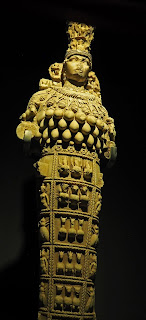Ephesus was one of the largest cities in the Roman Eastern Empire. At its peak it may have had 200,000 residents. For the detail of its rich history, here is the Wikipedia listing
Our visit started with the ruins of the Basilica of St. John
Built during the reign of Justinian in the 6th century (builder of the Hagia Sophia in Istanbul), it was one of the grand structures of the early Byzantine period.
It is always somewhat sad when I visit these ruins because you are seeing such a minute amount of what they were. So I decided in this case to show you what the Basilica would have looked like and its floor plan first
Now imagine you are looking up and down the long central bay of the church
And exploring more
The baptistry
Looking at the İsa Bey Mosque(built by the Seljuk Turks)
And the Ayasuluk Fortress, originally Byzantine, later expanded by the Seljuk Turks
Around the grounds
Just outside the Basilica grounds
In case you are in need of supplements
And a shot of color
There is all kinds of Christian associations in Ephesus including it being where the Apostle John went after the death of Christ, where Saint Paul preached and wrote, and where the Virgin Mary was supposed to have gone and spent her last days. There is a house that is reputed to be where she lived and died. Unless you are a believer, it is a lot of money and fighting of crowds for something that could be passed on.
Thought the proof that this is a holy place can be testified by evidence
Now to the City of Ephesus itself
Only a small portion of the ancient city has been excavated, the equivalent of the down town area
We entered to a pile of clay pipes
These were used for the municipal water system
This video shows the entrance to this section of the city
But, the hillside I am doing a panorama of was the location of the rest of the residential areas of the city
A Christian piece inserted in the reconstruction
The small theater
(Thank the Lord, we get our theater fix)
KNOW YOUR CAPITALS
Pay Attention!
There will be a contest on this information in a later post
Two Ionian capitals flanking a Corinthian capital
Two Doric capitals
Samples of various engraved decorations that would have been in the city
Making our way down to the central harbor area
This was the high rent district and there were ruins of 'terrace houses', an adjustment of the traditional Roman high end home design to fit the slope of this terrain
The public toilet showing its water flushing system
The everyday with the monumental
At the end of the street, the monumental gate to the Library, the third largest in the Roman world
Going from the Library to the Agora
The Agora covered an extremely large area
Road leading from the Library/Agora area to the port
View of the large theater that could seat 25,000
Lunch Break
Iskander Kebap
Donner meat served on a Pita bread with a tomato sauce and yogurt on the side
Durum Donner
Donner meat in a flat wrap
On to the Museum!
So many things from this part of the world were taken by Western Europeans during the later phases of the Ottoman Empire and now reside in Museums like London and Berlin
Still on the look out for a good deal on a great sarcophagus
Gold work from the 6th Century BC
These are statues of the Goddess of Artemis, Goddess of Fertility
Buying undergarments must have been a challenge but I suppose if you are a Goddess money is no question
The Temple to the Goddess was considered to be one of the Seven Wonders of the Ancient world with over 120 columns
Yet this is all that remains
Ashes to ashes. Dust to dust



























































No comments:
Post a Comment